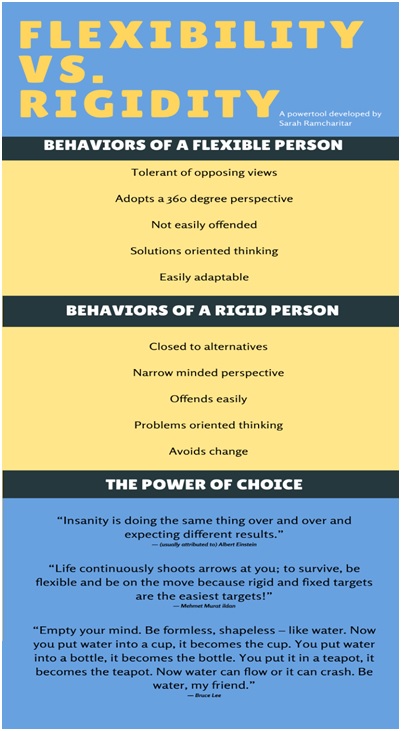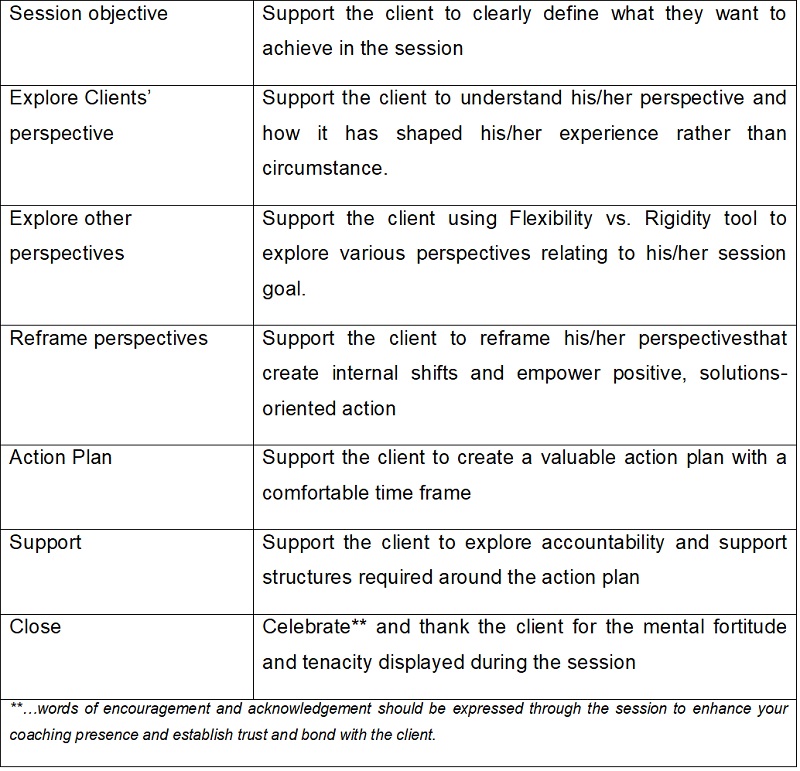A Coaching Power Tool Created by Sarah Ramcharitar
(Life Coach, TRINIDAD AND TOBAGO)
Introduction
Ever since I can remember visualizing my life metaphorically, I envisioned a roaring river, crashing against boulders of all sizes and eroding the side banks ferociously – I was a force to be reckoned with – even in my allegorical thoughts. For most of my early life I was thought to be a stubborn, unwavering, rigid, person – from childhood to early adulthood, I was set in my ways and crashing through everything like a “bull in a china shop”. Oblivious to anyone and everyone – their thoughts, perspectives, emotions, dreams. The world and everyone and everything in it was either for me or against me. That’s how I saw the world and how I shaped and influenced people’s perception of me. Mind you up until my late 20’s this perspective served me and served me well – in my opinion, that is! At work, I was considered Queen Bitch – don’t cross my path or you will be sorry! Resolutely successful at everything I did and unapologetically fierce!
Then at age 29 came motherhood and with-it medical challenges that threatened my unborn child. The absolute upheaval to my lenses through which I viewed life. A change that I was unprepared for. Within weeks I was engulfed with these warm, fuzzy, uncomfortable emotional concepts that placed someone else’s needs before mine. Suddenly Queen Bitch became caring, thoughtful, and compassionate. “Terra firma” became the choppy high seas of uncertainties. This left me shaky, insecure, unsure and confused. Unequipped with appropriate survival coping skills at the time, I wavered and struggled to be my old self – to survive this new landscape with old views.
Turns out I absolutely could not survive as successfully as I did, had I kept my old lenses. The years of motherhood, in retrospect now 21 years and 2 children later, have been and continue to be the most transformative and valuable years of soon to be 50 years of life (I turn 50 in August 2020). Being the resolute high achiever that I am, I found a way to not only survive but to thrive. I completely changed my lenses – forcibly at first – and then quite comfortably and naturally. Changing and adapting thoughts, perspectives, the importance of others, all ended up being my natural way of life. Gradually my allegorical perspective of life changed from that raging torrent to a placid stream flowing effortlessly along its meandering path. Instead of crashing against boulders – my stream of life found its way naturally around those boulders that I could not overcome and calmly covering and transcending over those that I could overcome. That 1st verse of the Serenity Prayer became my source of absolute strength during those years, and it continues to be so now:
God grant me the serenity, To accept the things, I cannot change; Courage to change the things I can; And wisdom to know the difference.
After much thought and reflection, I came to understand the importance of this prayer to the development of my inner shakti (divine energy). It was this prayer that nurtured and intensified my inner strength. Giving me all that was needed to continue to excel at living and being with different circumstances and challenges. Giving birth to my power tool – Flexibility vs Rigidity.
Flexibility vs. Rigidity
Explanation
Flexibility is “the quality of bending easily without breaking”; “the ability to change or be changed easily according to the situation” (English Dictionary, n.d.)
When using the word flexibility as an adjective for human behavior, it refers to a person who is not limited or constricted by societal norms and tendencies. A flexible person will be able to adjust his or her opinions and actions with ease, depending on the circumstance presented. He or she will also display a willingness to change and adapt as they see fit, so it is an easy adjustment for them resulting in less stressful reactions. He or she understands that mistakes are a part of life, learning, and development and so can adjust his or her thinking or behavior with extreme comfort. The quality of bending easily without breaking is of paramount importance when a person is flexible. It is an indicator of the inner strength of an individual. Stress emanates out of daily living and the challenges that they pose. When a person displays flexibility, it directly impacts his or her ability to view this stress as a positive construct and so maintain a healthier and stronger physical and mental being. Flexibility is a quality which breeds harmony, creative solutions, and progressive result.
Rigidity is “the quality of being impossible to change or persuade.” (English Dictionary, n.d.)
A rigid person is not yielding in their judgments and actions. For example, an employer who penalizes you for being late even though you were busy saving your neighbor’s family from their burning house. It means not bending, no matter what. Rigidity is a quality that breeds selfish behavior, stagnancy, and stunted progress.
The table below highlights the qualities of each of the concepts followed by the importance of choice in the mix. For the power to choose which of the concepts or where on the spectrum we choose to operate are within us.

These polar concepts can and do serve us at different times in our lives and varying degrees of each are required depending on the circumstances. It is the unequivocal choice of one or the other at different times, which causes us to be paralyzed when faced with difficulties and obstacles in our path. That limiting view of either-or, black or white. Extremes of contexts that do not allow us to expand our views to incorporate others and the impact our actions have on others.
Understanding and application of this powerful tool allow us to view multiple perspectives thereby arriving at a “best for all solution” rather than a “best for me solution”.
Carol Dweck is a Stanford University psychologist. Her studies over 40 years concluded that “Knowing the distinction between a growth and fixed mindsets gives you a new choice”(Jeffery, n.d.)This model and the qualities of Flexibility vs. Rigidity and the entire spectrum that lies between allow me to view and value a multitude of perspectives when facing any situation. It has made me somewhat invincible in the face of adversity as I understand to my core that there will always be a solution.
Coaching Application
The saying “Change is the only constant in life” has been attributed to Heraclitus. His philosophical works have influenced the writings of Aristotle and Plato. He considered himself to be the only philosopher of his time (>500 BC) and postured that
The way up and the way down are the same. Living and dead, waking and sleeping, young and old, are the same.” These things are the ‘same’ in that they are all subject to change, arise from one change to vanish into another and all things, constantly, are in flux and are, in that regard, the same. Heraclitus (Mark, 2010)
Is there a universal principle inherent in a philosophy that has survived for centuries? When I think of it, I can only answer in the affirmative. As such the coaching application of Flexibility vs. Rigidity is based on the acceptance of this constancy of change in our lives and the necessity of adaptation as a survival mechanism.
Fundamental to the use of this power tool is awareness of one’s constructs of Flexibility and Rigidity and acceptance of the need to adapt to different circumstances.
If a person holds on to being too rigid, then decisions can be more grounded in emotion and irrationality. This has its basket of negative consequences. If a person holds on to being too flexible then he or she can expose himself or herself to being used, abused, or taken advantage of. This too has its basket of negative consequences. As such some semblance of balance and appropriateness must be achieved along the spectrum of Flexibility and Rigidity to ensure the successful application of this tool.
So how do we do this? By using the range of coaching skills from powerful listening, to powerful questioning to gratitude, we help them to raise their awareness surrounding their constructs of flexibility and rigidity. We continue the exploration into what would be the impact on the scenario they are trying to resolve and which part of the spectrum they need to operate on to gain the best results for them. By allowing the client to explore options in this manner he/she can generate ideas and goals that they would not have ordinarily been able to generate.
General application framework

Examples of powerful questions surrounding Flexibility vs. Rigidity:
Reflection
The development and creation of this power tool have certainly been a journey worth the time and effort to bring to fruition. I have undergone the process of thoughtful remembrance, internal searching and dialogue, research, and reflective writing to develop this power tool. It has underscored my journey with this tool and a stark realization of how our minds do indeed find ways to survive challenges. For us to live in a manner of full acceptance of a world full of potential and options we need to foster and encourage open thinking and open dialogue. Free from not only external judgment and bias but also injurious, self-deprecating dialogue that serves to sabotage our dreams and hopes. A valuable space that is provided by the coaching process. My journey through ICA has helped me tremendously to understand this and I see myself as the living example of this power tool at work. I reached the doorstep of ICA because I believe in the concept of a flexible mindset. I am well set to exit the ICA door and embark on the road to transforming my professional life away from Accountancy and towards Coaching. Poised to embrace my full potential and live by what is truly my greater calling and purpose in life, I remain a person grateful for all the experiences that have shaped and built my flexible approach to life.
References
English Dictionary. (n.d.). Retrieved 2020, from Cambridge Dictionary: https://dictionary.cambridge.org/dictionary/english/flexibility
Jeffery, S. (n.d.). CE Sage. Retrieved July 14, 2020, from Jeffery Scott.com: https://scottjeffrey.com/change-your-fixed-mindset/
Mark, J. J. (2010, July 14). Ancient History Encyclopedia. Retrieved July 14, 2020, from Heraclitus of Ephesus: https://www.ancient.eu/Heraclitus_of_Ephesos/
